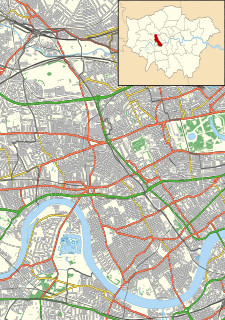
Whipps Cross University Hospital is a large university hospital in the locality of Whipps Cross in Leytonstone and is within Epping Forest in the London Borough of Waltham Forest, London, England. It is managed by Barts Health NHS Trust.

North Manchester General Hospital (NMGH) is a large NHS hospital in Crumpsall, North Manchester, England. It is operated by Manchester University NHS Foundation Trust. There is an accident and emergency unit, together with a maternity unit, high dependency unit and a mental health wing. A plan to rebuild the hospital was announced by Boris Johnson in the 2019 General Election campaign, and in November 2020 a £54 million funding bid for improvement works was made by the Trust, Manchester City Council, and Manchester Health and Care Commissioning.
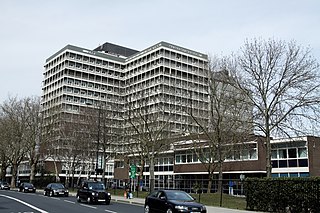
Charing Cross Hospital is an acute general teaching hospital located in Hammersmith, London, United Kingdom. The present hospital was opened in 1973, although it was originally established in 1818, approximately five miles east, in central London.

Hammersmith Hospital, formerly the Military Orthopaedic Hospital, and later the Special Surgical Hospital, is a major teaching hospital in White City, West London. It is part of Imperial College Healthcare NHS Trust in the London Borough of Hammersmith and Fulham, and is associated with the Imperial College Faculty of Medicine. Confusingly the hospital is not in Hammersmith but is located in White City adjacent to Wormwood Scrubs and East Acton.

Selly Oak Hospital was situated in the Selly Oak area of Birmingham, England. Previously managed by the University Hospitals Birmingham NHS Foundation Trust, the hospital closed in 2011.
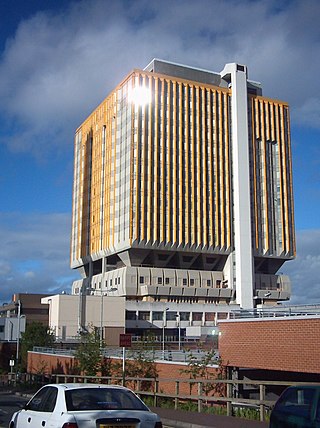
The Belfast City Hospital in Belfast, Northern Ireland, is a 900-bed modern university teaching hospital providing local acute services and key regional specialities. Its distinctive orange tower block dominates the Belfast skyline being the third tallest storeyed building in Ireland. It has a focus on the development of regional cancer and renal services. It is managed by Belfast Health and Social Care Trust and is the largest general hospital in the United Kingdom. In April 2020, due to the global coronavirus pandemic, the tower block was designated one of the UK's Nightingale Hospitals.

Leicester General Hospital (LGH) is a National Health Service hospital located in the suburb of Evington, about three miles east of Leicester City Centre, and is a part of University Hospitals of Leicester NHS Trust. It has approximately 430 beds. The hospital is the largest employer in the area.
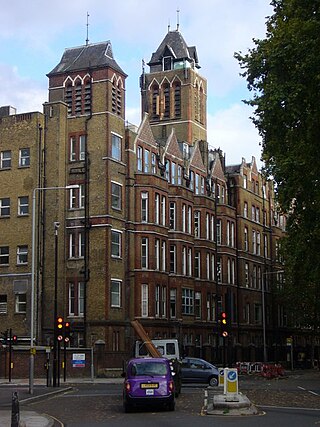
St Pancras Hospital is part of the Camden and Islington NHS Foundation Trust in St Pancras area of Central London, near Camden Town. The hospital specialises in geriatric and psychiatric medicine.

The North Infirmary was the first general hospital to be opened in Cork. Originally holding only 24 beds, it eventually expanded to 115 beds. It was used as a fever hospital during the famine, housed Irish soldiers wounded in the First World War and covertly treated wounded Republicans during the War of Independence. The infirmary closed its doors on 26 November 1987, and is now a hotel.

University Hospital Lewisham is a teaching hospital run by Lewisham and Greenwich NHS Trust and serving the London Borough of Lewisham. It is now affiliated with King's College London and forms part of the King's Health Partners academic health science centre. It is situated on Lewisham High Street between Lewisham and Catford.
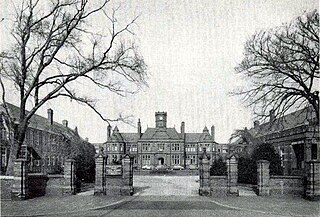
Southport General Infirmary was a Victorian hospital that was Southport's first major hospital. The first construction of the building started in October 1892, with the first patients being seen at the hospital in September 1895.
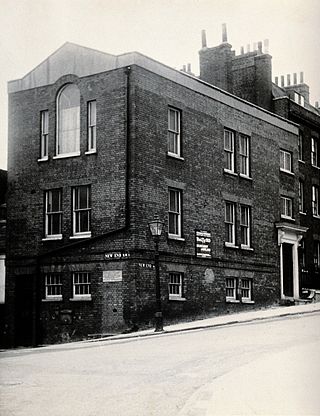
New End Hospital was a hospital in Hampstead, north London. It was founded in 1869 as the infirmary for the Hampstead Union workhouse, and operated until 1986. The buildings have now been redeveloped as housing.

Southlands Hospital is a medical facility based in Shoreham-by-Sea, West Sussex, England, which serves people living in Shoreham itself as well as Worthing and other towns and villages along the south coast and in the inland areas of West Sussex. It is managed by the University Hospitals Sussex NHS Foundation Trust.
A timeline of the Imperial College School of Medicine, the medical school of Imperial College London.

The West London Hospital was founded in 1856 as the Fulham and Hammersmith General Dispensary, which was housed in a small 6-roomed building in Queen Street, Hammersmith. It catered for acute conditions and later for geriatric, maternity, rehabilitation and long-stay conditions.

St Alfege's Hospital was a hospital that operated in the Maze Hill area of east Greenwich in southeast London. It operated as the Greenwich Union Infirmary from 1874 to 1929. It was briefly known as the Greenwich and Deptford Hospital before becoming St Alfege's Hospital in 1931. It was then superseded by Greenwich District Hospital in 1968.
St James' Hospital was a healthcare facility in Balham, London that existed between 1910 and 1988. The hospital buildings occupied sites within the boundary of Ouseley Road, Sarsfield Road and St James's Drive Balham London SW12.

Dulwich Community Hospital was a hospital located in Dulwich, in South London.
Bethnal Green Hospital was an acute care hospital, in the Bethnal Green area of the London Borough of Tower Hamlets, England. It opened in 1900, and it closed in 1990.
